The Enigmatic Revolutionary 1-Centavo . . .
by David Hughes
I have always liked the Enigmatic 1-centavos, since first reading about them in the 1965 Neil Utberg book Neil Utberg, The Coins of the Mexican Revolution 1910-1917, Edinburg, Texas, 1965. I hoped to puzzle them out or unearth an insight, perhaps, despite this great time and distance from Revolutionary Mexico.
The Enigmatics are rough copies of the Federal 1-centavo, usually poorly struck. Both Angel Smith and myself noted the similarities between the 1910-M Enigmatic 1-centavo and the extremely rare terracotta clay Texcoco, Estado de México 1915 1-centavo (GB-262) during an open question session at Richard Long’s 1996 ANA Summer Class.
And so, in the order they were first reported in the hobby . . . .
1910-M 1-centavo
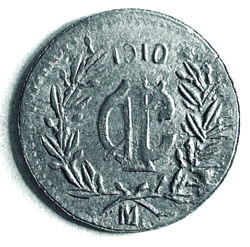
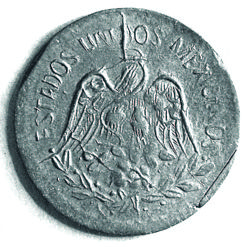
1910-M 1-centavo, the first reported Revolutionary Enigmatic, catalogued by Garza J. Sanchez Garza, Historic Notes on Coins of the Mexican Revolution, 1913-1917, Mexico City, 1932 in 1932 as No. 142c, noted as being struck possibly in Guanajuato by some Revolutionary chief. Summarized in the Chicago Coin Club, October 2007, as “An enigmatic issue resembling a [Mexican] 1 centavo, not counterfeit, but we do not know who made it. From early in the Revolution, it is styled upon the 1 centavo of Guanajuato [?], but the wreath is different and the obverse eagle does not have a head.”
There actually is an eagle head, small and poorly engraved. Later die states show a die crack through the D of ESTADOS and the snake head, joining another die crack from the top of the left eagle wing through the eagle head, as shown above. This piece has similarities to the terracotta clay Texcoco, EoMo 1915 1-centavo. GaytanCarlos Gaytan, La Revolución Mexicana y sus Monedas, Mexico City, [1969] tried to place it in Puebla, and called it a 1915, although his photo shows the 1910 date. The 1910-M is the most common of the Enigmatics, seeming too common to be a circulating counterfeit. They made enough of them to break up the dies. This example is an unusually nicely struck and lustrous piece for the issue.
1906-M 1-centavo
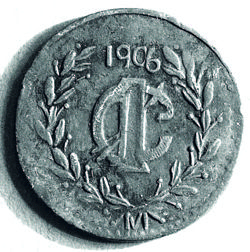
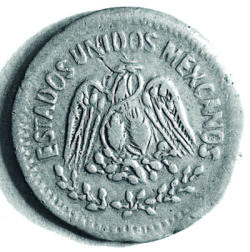
UtbergUtberg, op. cit. 1906-M 1-centavo, with MEXICANOS misspelled as MEXCANOS. There is a 1906-M 2-centavos struck circulating counterfeit. Is it similar to the 1906 Enigmatic? No, the 2-centavos is correctly spelled and nicely done compared to the 1-centavo, although obviously counterfeit when compared to an original (probably a piece produced in the US and smuggled into Mexico, back in the day). This is the second-most common of the Enigmatics. Utberg also mentioned, but did not picture, the 1911 catalogued by Gaytan (below).
1911 1-centavo
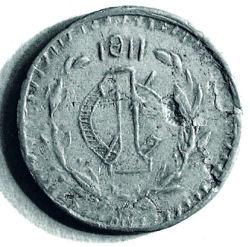
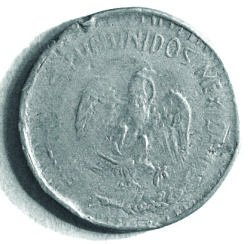
GaytanGaytan, op. cit. catalogued a 1911-(M?) Enigmatic 1-centavo. Gaytan called it a 1915, although his photo shows the 1911 date. Gaytan claimed to see a mintmark P, but I cannot spot it, it looks more like the ruins of an M with a planchet lamination running through it. The 9 of the date is an upright 9: the tail of the 9 extends up to the head of the 9. The eagle side appears double struck, with poorly defined letters, including UN, in the (oversize) space between ESTADOS (poorly struck, but there) and UNIDOS, and doubling in the left eagle wing.
This piece, reported unique, was obtained from Garza in 1956, who challenged Gaytan to find out more about the coinGaytan, ibid., p. 213-214. Gaytan suggested a P mintmark with a connection to Puebla and the first gunfire of the Madero Revolution in the unrest of 1910.
1905 1-centavo
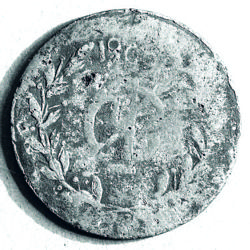
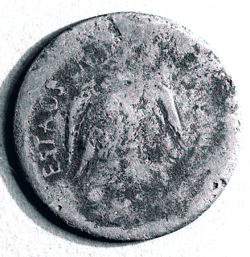
WalrafenVerne R. Walrafen, The Mexican Revolution Reporter,May 1978 notes a poorly struck and worn brass 1905 1-centavo, with ESTADOS misspelled as ESTAOS. There does not appear to be a mintmark, or it may be lost in the poor strike. It is struck with different dies compared to the 1906 Utberg.
1916-G 1-centavo
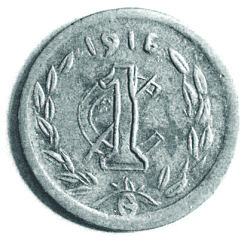
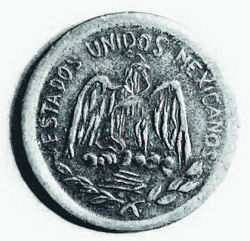
The modern “1916-G” fantasy 1-centavo, crude dies but nice planchet and strike (unlike virtually every other Zapatista coin), noted in LongRichard Long, Mail Auction Sale #81, 25 March 1996 (Karam remainder sale), Langlois, Oregon: Mail Auction Sale #85, 7 April 1997 (third Cortina sale), photo and described as a fantasy in AmayaCarlos Amaya, Compendio de la Moneda de la Revolución Mexicana, Segunda edición, Mexico, 2011: Tricolor Compendium of Mexican Revolutionary Coinage, Monterrey, Mexico, 2015. This is likely out of the1960s Guadalajara counterfeit-fantasy-shop that produced a plethora of bogus pieces that still plague the hobby, showing up on eBay as “RARE!!!” and “UNLISTED!!!”.
1911 1-centavo

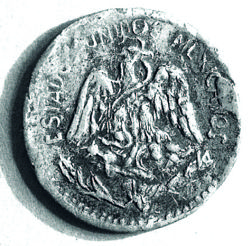
1911 Karam 1-centavo, in Long’s 1996 saleRichard Long, Mail Auction Sale #81, 25 March 1996 (Karam remainder sale). Of all the Enigmatics, this piece looks most like a Zapatista-engraved coin, on a Zapatista-type brass streaked planchet. There is definitely no mintmark below the wreath tie. This is the second catalogued 1911 Enigmatic, two known out of the Karam collection auctioned by Richard Long. Karam’s notes on a 2x2 holder calls out one piece as x-Gaytan and believed unique until the second piece appeared. 1911 is the year of the Plan de Ayala of the Zapatistas, suggesting a possible spiritual connection with the date.
1909-M 1-centavo
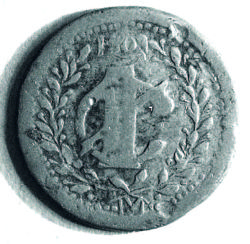
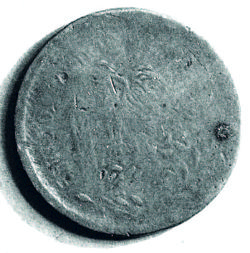
1909-M Cortina 1-centavo, in LongLong, Mail Auction Sale #85, 7 April 1997 (third Cortina sale) and AmayaAmaya, op. cit.. Crude engraving and strike, very weak eagle side.
1911 1-centavo
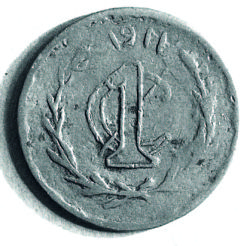
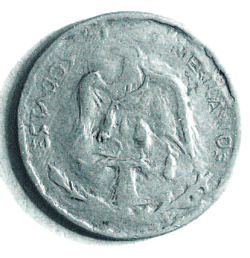
1911 Cortina 1-centavo, with a retrograde D in ESTADOS and unusually shaped S’s, in WalrafenWalrafen, op. cit., Long{foootnote}Long, op. cit. and Amaya. This is the third different 1911, marking a banner year amongst the Enigmatics.
No mintmark, poorly engraved eagle side. Amaya notes four pieces are known. Even less, if possible, is known about this crude piece.
AmayaAmaya, Tricolor Compendium of Mexican Revolutionary Coinage, p. 129 notes a (missing date)-M 1-centavo [date missing from poor strike and/or misaligned dies], that he calls a copper counterfeit of the terracotta clay Texcoco, EoMo 1915 1-centavo GB-262. This, instead, appears to be another Enigmatic of the time. His photos do not match any of the above coins.
Noticing this proliferation of Enigmatics, including the overuse of the word by Amaya to cover everything from metal varieties to counterfeits to striking vagaries, I suggest the 1910 and the three 1911s are Revolutionary coins. Logic suggests, if Revolutionary, the dates would be in the 1910-1921 range. Garza places the 1910, and by his 1956 comments to Gaytan, the 1911 Gaytan in the Revolution issues. Garza, in 1932 Mexico, was much closer to the action than I am in 2020 North California, and I defer to him. The no-mintmark 1911s also suggest a Revolutionary origin, as circulating counterfeits would be expected to copy the standard M mintmark.
What does this suggest for the off -year Enigmatics? Are they circulating counterfeits or mis-dated Revolutionary issues?
There is no political profit made producing a mis-dated Revolutionary coin. Separatist Oaxaca, in 1915, found they spent 2.004626 centavos each (to 6 decimal places!), to prepare 2,600 nicely-struck 1-centavo coins at the Oaxaca State Mint during the month of April 1915[ ] Clyde Hubbard remarked the accountant must have studied in Germany.. The Free and Sovereign State of Oaxaca lost approximately 1 centavo for each centavo coin placed in circulation. By the Mint Report, they were paying wages of some sort, thereby increasing the price of the product. A counterfeiter would “pay” these wages to himself, and a crude product is cheaper to produce.
Therefore, I suggest the other Enigmatic 1-centavo (that is, the 1905 Walrafen, 1906-M Utberg, and 1909-M Cortina) are circulating counterfeits, local products, struck in Mexico. Perhaps these rather crude pieces passed because no one really looked at a 1-centavo, and the poor strikes could be attributed to wear. Although there was likely not much profit in the 1-centavo trade, it was certainly safer than counterfeiting peso coins.
And finally, the modern c.1960s fantasy “1916-G” 1-centavo. Of interest only as a curiosity and should be discouraged when encountered. Dangerous, as some of these have been in collections for over 50 years, unfortunately. Watch for these and others on eBay, in the hundreds of dollars. Amuse yourself by reporting them.
| The Enigmatic 1-Centavo in the Literature, in Order of Occurrence | ||||||||
| 1910-M Garza |
1906-M Utberg |
1911-(M?) Gaytan |
1905 VRW (VRW ‘78) |
"1916-G" Fantasy |
1911 Karam (Long ‘96) |
1909-M Cortina (Long ‘97) |
1911 Cortina (Long ‘97) |
|
| Garza (1932) | X | |||||||
| Utberg (1965 | X | X | Mention | |||||
| Gaytan (1969) | X | X | ||||||
| Walrafen (MRR) | Photo | Photo | ||||||
| Long (auctions) | X | in Lot | X | In Lot | X | in Lot | in Lot | |
| Amaya | X | X | X | X | X | X | ||
